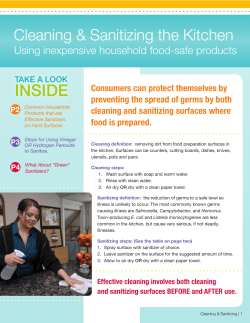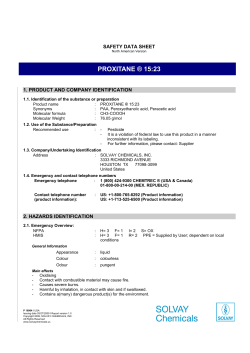
Technology Information Summary Purified Hydrogen Peroxide Gas Technology June 2009
Purified Hydrogen Peroxide Gas Technology __________________________________________________________ Technology Information Summary June 2009 Purified Hydrogen Peroxide Gas Technology At a Glance CAPABILITIES Technology Category: Applications: Detection Water security Decontamination Building structures Sampling Building materials Targets: Air Biological agents Chemical agents Toxic industrial chemicals Radiological agents Other FIELD CONSIDERATIONS Weighs <10 lb Batteries AC current Explosive atmosphere operation Novice operator Skilled operator Audible alarm Visible alarm INFORMATION Information Sources: No vendor response General info only Vendor-supplied info 3rd party test data Information Provided: General product Performance Cost OVERVIEW OF TECHNOLOGY Purified Hydrogen Peroxide Gas (PHPG) technology is an infection control and microbial threat reduction technology designed for continuous use in occupied spaces. PHPG technology produces hydrogen peroxide catalytically from ambient oxygen and water vapor present in the air. The hydrogen peroxide is then disseminated onto surfaces where it disinfects harmful microbes or can be used for acute decontamination in response to a bioagent exposure. PHPG technology is designed for use in healthcare facilities, workplace environments, educational facilities, mass transit, athletic facilities, entertainment venues, and government and military facilities. Variations of PHPG technology are designed for duct, room, plenum, and air return deployment. PERFORMANCE Tested while generating 0.01 ppm hydrogen peroxide (1% of the OSHA workplace safety limit), PHPG killed 99.9999% of both methicillinresistant staphylococcus aureus (MRSA) and vancomycin-resistant enterococci (VRE), as well as significant amounts of clostridium difficile (CDiff), feline calicivirus (an EPA-approved surrogate for norovirus), and common mold in the air and on surfaces in a protected area within two hours of activation. Produces ambient equivalent concentrations of hydrogen peroxide as high as 0.20 ppm in a 71 m3 (2500 cu ft) room within 15 min of activation, well within workplace safety limits set by OSHA. DEPLOYMENT Weighs about 2 kg (5 lb) and measures approximately 36 cm x 15 cm x 15 cm (14 in x 6 in x 6 in). Should be operated in relative humidty between 30% and 99% for optimal performance. Dust filter requires replacement every 3 months, more frequently in high dust areas; photocatalytic insert should be replaced annually. UV light should be replaced after 5,000 - 7,000 h of use. Vendor Information: Company: Lee Antimicrobial Solutions Address: Harborside Financial Center 2500 Plaza 5 Jersey City, NJ 07311 Phone: 1-201-633-3605 Fax: 1-201-633-4676 E-mail: casey.dougan@leeantimicrobial.com Web: www.leeantimicrobial.com Disclaimer: Support for this report has been provided by the U.S. Environmental Protection Agency under Contract No. GS-23F-0011L SIN 871-3. References in this report to any specific commercial product, process, or service by trade name, trademark, manufacturer, or otherwise does not constitute or imply the endorsement, recommendation, or favor of the U.S. Government. U.S. EPA ORD NHSRC 1 June 2009 Purified Hydrogen Peroxide Gas Technology __________________________________________________________ PRODUCT DESCRIPTION PRODUCT DESCRIPTION: Purified Hydrogen Peroxide Gas (PHPG) technology is an infection control and microbial threat reduction technology that produces hydrogen peroxide catalytically from ambient oxygen and water vapor present in the air. The catalytically generated hydrogen peroxide is substantially free of hydration. Unattenuated by bonded water, the generated hydrogen peroxide is electrostatically attracted to the charged structures on microbes. Intended for continuous use in occupied spaces, the amount of hydrogen peroxide produced is within Occupational Safety and Health Adminstration (OSHA) guidelines. In addition, PHPG is substantially free of ozone, photo-catalytic plasma, and volatile organic hydrocarbons (VOC), each of which inhibits the production of hydrogen peroxide gas and is objectionable for health considerations. INTENDED USERS: PHPG technology is designed for use by untrained operators in healthcare facilities, workplace environments, educational facilities, mass transit, athletic facilities, entertainment venues, and government and military facilities. It can also be used by HazMat personnel to decontaminate facilities. UTILITY REQUIREMENTS: Standard wall outlet 120 VAC power. DURABILITY/RUGGEDNESS: PHPG technology is constructed with a high density polyethylene frame for maximum durability against force. Standard units are intended for stationary use. Reinforced units can be manufactured to specification. APPLICATIONS: PHPG technology is designed to continuously provide surface disinfection in occupied indoor spaces following OSHA guidelines. PHPG technology can also be used for acute decontamination in response to exposure of a bioagent. Variations of the technology are designed for duct, room, plenum, and air return deployment. SOPS, METHODS, USERS MANUALS: Includes a user manual. ACCESSORIES/COMPONENTS: A preassembled PHPG unit includes: one dust filter, one photocatalytic insert, one UV light, and one AC power adapter. THROUGHPUT OF PRODUCT: PHPG technology requires no time for setup beyond planning for location and connecting to AC power. Within 15 minutes of activation, PHPG technology can consistently produce ambient equilibrium concentrations of hydrogen peroxide as high as 0.20 ppm in a 71 m3 (2500 cu ft) room. The time needed to decontaminate various microbes may vary; however, PHPG can remove significant amounts of many microbes within two hours of activation. PORTABILITY: PHPG technology is approximately 36 cm x 15 cm x 15 cm (14 in x 6 in x 6 in) and weighs about 2 kg (5 lb). Units do not require installation but may be mounted on walls as needed. OPERATION/MAINTENANCE: The unit is plugged into an AC outlet and switched into the ON position. PHPG technology should be operated in relative humidity between 30% and 99%. Operating with less than 30% relative humidity could compromise performance. Occasional maintenance is necessary to ensure optimal operation. The UV light must be replaced after approximately 5,000 – 7,000 h of use. The dust filter must be replaced every 3 months and should be replaced more frequently in high dust areas. The photocatalytic insert should be replaced approximately once a year. DECONTAMINATION/REUSE: PHPG technology is reusable and designed for continual use. Contaminated devices should be placed into operation in a contained area for 24 h to facilitate self-decontamination. Filters should be replaced following decontamination. TRAINING: No training is required. To ensure optimal spacing of multiple devices, the installation and placement planning should be performed by a trained professional. TECHNICAL SUPPORT: Technical support is available at 1-201-633-3605 Monday-Friday from 9:00 am - 5:00 pm (EST) or via e-mail at info@leeantimicrobial.com. HEALTH/SAFETY -- PERSONNEL HAZARDS AND PUBLIC HEALTH HAZARDS: PHPG technology produces up to 20% of the 1.0 ppm workplace safety limits for hydrogen peroxide set by OSHA, the National Institute for Occupational Safety and Health (NIOSH), and the American Conference of Governmental Industrial Hygienists (ACGIH). OSHA’s permissible exposure limit (PEL) is 1.0 ppm (continuous) over the course of five days of 8-h work shifts repeated weekly.1 NIOSH’s recommended exposure limit (REL) is 1.0 ppm as a time-weighted average for up to a 10-h workday and a 40-h work week.2 ACGIH has assigned hydrogen peroxide a threshold limit value (TLV) of 1 ppm as a time-weighted average for a 8-h workday and a 40-h workweek.3 In areas with active airflow, the maximum equilibrium concentration of hydrogen peroxide generated by PHPG technology (0.20 ppm) provides for less cumulative exposure, even on a continuous long-term basis, than is allowed by the OSHA PEL. The gaseous hydrogen peroxide cannot establish concentrations above 0.20 ppm because molecules react with each other, decomposing back into gaseous H2O and O2. A November 2008 study in The Annals of Occupational Hygiene4 reported workers who were exposed to 0.093 ppm of hydrogen peroxide experienced nasal and eye irritation symptoms at a rate comparable to unexposed persons. The internal UV light source poses no external hazard unless exposed due to unit damage. Damaged units should not be used. HEALTH/SAFETY -- ENVIRONMENTAL HAZARDS: Purified hydrogen peroxide gas decomposes into trace amounts of gaseous oxygen and water vapor. U.S. EPA ORD NHSRC 2 June 2009 Purified Hydrogen Peroxide Gas Technology __________________________________________________________ PERFORMANCE SUMMARY DECONTAMINATION TECHNOLOGIES: When tested in two accredited laboratories, PHPG technology generating 0.01 ppm hydrogen peroxide (1% of the OSHA workplace safety limit) killed 99.9999% of both methicillin-resistant staphylococcus aureus (MRSA) and vancomycin-resistant enterococci (VRE), as well as significant amounts of clostridium difficile (C-Diff), feline calicivirus (an EPA-approved surrogate for norovirus), and common mold in the air and on surfaces in a protected area within two hours of activation. Materials tested with concentrations of hydrogen peroxide at levels generated by PHPG technology have shown no damaging effects during the course of time required to achieve decontamination. No post-treatment procedures are necessary. INTERFERENCES: PHPG technology operates most effectively at 30% or higher relative humidity. Operating PHPG technology in environments containing excessive dust could cause less than optimal performance. Environments containing continuous sources of VOC's may cause less than optimal performance. COST INFORMATION Category Accessories/Components Consumables Maintenance Warranties Technical Service Item Cost $755 PHPG unit: (1) Dust filter (1) Photocatalytic insert (1) UV light (1) AC power adapter $ 25 Photocatalytic insert $ 25 Dust filter $100 UV light N/A Full replacement of photocatalytic insert if failure occurs within 6 months of purchase date. N/A REFERENCES AND ADDITIONAL INFORMATION JOURNAL REFERENCES: 1) “Toxic and Hazardous Substances: Table Z-1 Limits for Air Contaminants.” Occupational Safety and Health Standards. 29 CFR 1910.1000 Table Z-1. 2) “Recommendations for occupational safety and health: Compendium of policy documents and statements.” Cincinnati, OH: U.S. Department of Health and Human Services, Public Health Service, Centers for Disease Control, National Institute for Occupational Safety and Health, DHHS (NIOSH) Publication No. 92-100. 3) “1993 Emergency Response Guidebook, Guide 45 and 47”. Washington, DC: U.S. Department of Transportation. 4) Mastrangelo, G. et al., “Exposure to Hydrogen Peroxide and Eye and Nose Symptoms Among Workers in a Beverage Processing Plant.” The Annals of Occupational Hygiene. 7 Nov. 2008: 1-5. EVALUATIONS/REVIEWS: “A Study of Performance Characteristics of Purified Hydrogen Peroxide Gas Diffuser.” Alliance Technologies, Monmouth Junction, NJ. 2 Sept. 2008. Gutzmann, Kelleen, “Virucidal Efficacy Evaluation of Hydrogen Peroxide Generating Unit.” ATS Laboratories, Eagan, MN. 11 Aug. 2008. Steinagel, Scott R. “Disinfection Efficacy Evaluation of Hydrogen Peroxide Generating Unit.” ATS Laboratories, Eagan, MN. 7 Aug. 2008. FOR FURTHER INFORMATION ABOUT THIS REPORT AND EPA’S TECHNOLOGY TESTING AND EVALUATION PROGRAM (TTEP), CONTACT: Shannon Serre U.S. EPA ORD/NHSRC (919) 541-3817 serre.shannon@epa.gov http://www.epa.gov/nhsrc/ttep.html U.S. EPA ORD NHSRC 3 June 2009
© Copyright 2025





















